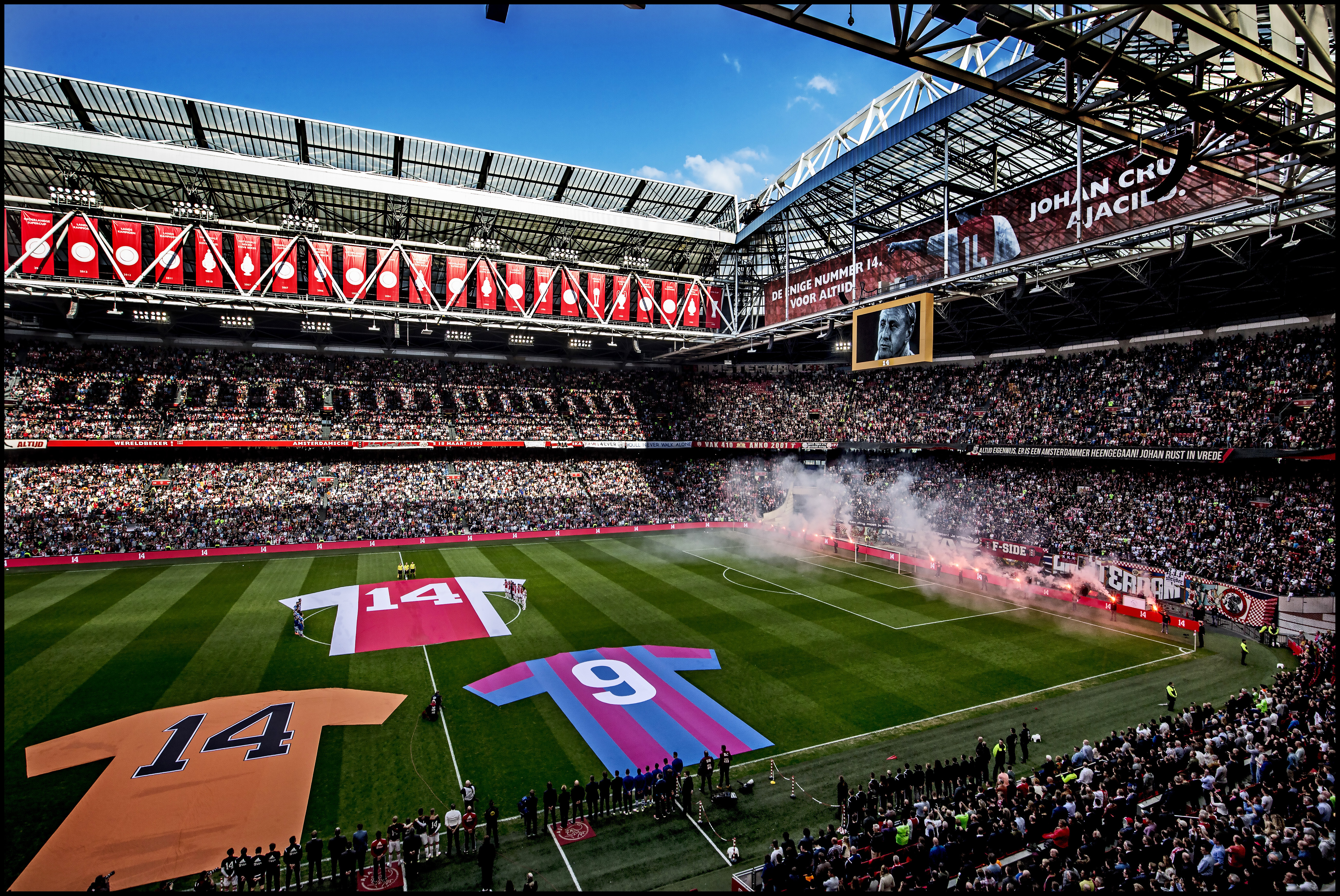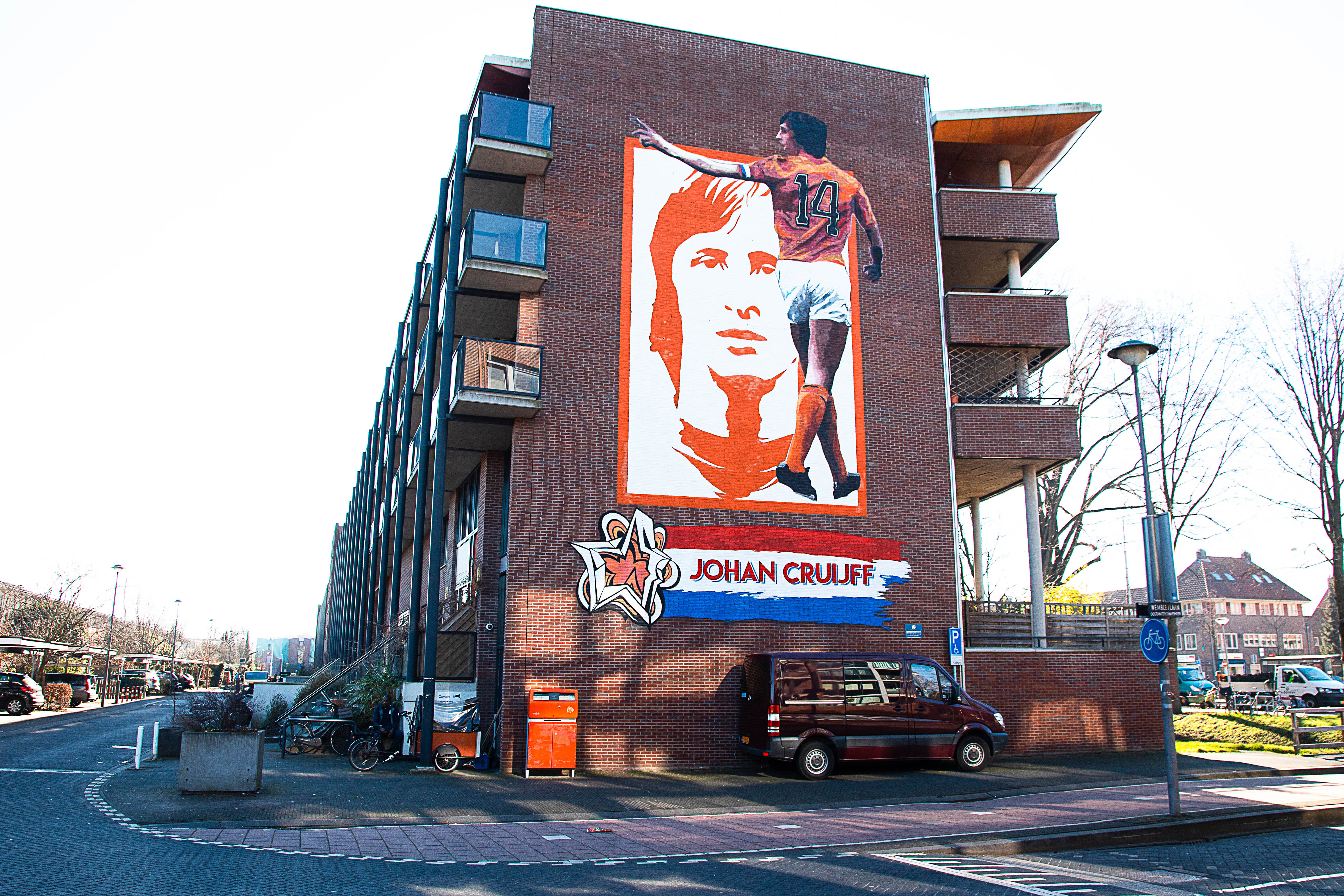

Amsterdam is home to only one professional football club, but also the most successful club in the country. And even though the Johan Cruyff Arena was not immediately loved by Ajax fans, it eventually stole their hearts. Anywhere you will go in Amsterdam you will find traces of Ajax.
Warm-up on Rembrandt Square
Since the 1970s, Rembrandt Square has become the hotspot for a pre-drink for Ajax fans, especially on European nights. From there you can take metro 54 from Waterlooplein to the Johan Cruyff Arena.
Rembrandt Square lights up with festivities and a sea of red and white supporters when Ajax is playing a European home match. Café Monico rolls the beer tap outside and the fans will sing long before kick-off. Café Los is full of Ajax fans and so is café ‘t Centrum, where the loyal fans have been coming for years. The away fans tend to go for drinks around Dam Square and De Wallen.
Cool (Retro-)kits
The Copa Football store is a shop you cannot miss on your next visit to Amsterdam. A paradise full of retro kits and football culture, right across Amsterdam Central Station on the Prins Hendrikkade 21A.
The embraced Johan Cruyff Arena

It took a while for Ajax fans to fall in love with the Johan Cruyff Arena. When Ajax moved into the modern theatre in 1996 it was full of flaws. A pitch that was always damaged, too many dull concrete walls, almost zero references to Ajax and ugly patterned seats.
But the ugly stadium grew in its beauty and has become a place full of enthusiasm, especially on European nights. The endless concrete halls have disappeared and the windy corners have been filled with seats. Since then, the stadium has got 55.000 (red) seats. The grass is healthy and green. And on top of that, the name is even more beautiful now after they changed the name from Amsterdam Arena to the Johan Cruyff Arena in 2018. Of course, named after one of the best players the world has ever seen.
Pre-drinks nearby
When the Johan Cruyff Arena was built in 1996, in the heart of the neighbourhood of Bijlmermeer, the surrounding area was empty. Nowadays, there are many restaurants. Even though the suburb will never be like the city centre, the beer surely does not disappoint in places such as JinSo, Boulevard Fourteen and the Grolsch Pub.
Stadium tour
It is a bit of an obvious tip, but take a tour through the stadium with the Museum World of Ajax and the impressive trophy cabinet as your final destination. Look out for the bronze statues of Johan Cruyff and former player and assistant manager Bobby Haarms at the main entrance.
Olympic Stadium: restored to its former glory
The Olympic Stadium is nowadays way more beautiful than it was between 1961-1996 when Ajax used to play their home games there. In those years it was a rundown stadium with an added second row of stands behind both goals. The pungent smell of piss, however, was legendary.
Right now the stadium blossoms as it did back in 1928 when it was the main stadium of the Olympic Games. With its red-brown bricks, it fits the surrounding area. Former professional clubs Blauw-Wit, DWS and FC Amsterdam used to play in the stadium during their heydays.
In the footsteps of the beautifully rough De Meer

The newly built neighbourhood across the Betondorp neighbourhood consists of some references to the beautifully rough former stadium De Meer, which stood here from 1934 to 1996. The neighbourhood is called Park De Meer, the wooden bridges are named after former Ajax players from the seventies and the streets have the names of stadiums where Ajax achieved success.
On the corner of Anfieldroad/Wembleylaan is an immense mural of Johan Cruyff in a Dutch kit, even though he never wore that shirt in Ajax's former stadium. On the facades, you will find stand signs (Vak C, Vak J, Vak L…) and in the playground, a ball of stone arises from the pavement. This is supposed to be the centre spot of the former pitch, but in fact, this is not the correct location of it.
Betondorp, where the big one was a little kid
It feels like time has stood still in the Betondorp neighbourhood of Amsterdam. This is where Johan Cruyff grew up on Akkerstraat 32. The house barely changed, the only thing missing is the vegetable shop of his father Manus Cruyff.
When Manus passed away in 1959, the family moved just a couple of blocks away to the Weidestraat 37, where Johan lived until 1968, when he already was the star player of Ajax’s first team.
On the outskirts of the neighbourhood was Bar Meerzicht, which was the home base of Ajax’s ultras when they used to play in stadium De Meer. Nowadays, you will find café De Avonden, named after the other notable player from Betondorp: Gerard Reve. Still full of Ajax ambience, but not as scary anymore.
Tickets
Tickets can be bought on the official website of Ajax. However, do be aware of the fact that most of the time the Johan Cruyff Arena is one of the only stadiums in The Netherlands that tends to be sold out.
How to get there
The Johan Cruyff Arena is located right next to the Amsterdam Bijlmer Arena train and metro station which are very well connected to the city centre.
Images: Pim Ras, ANP





